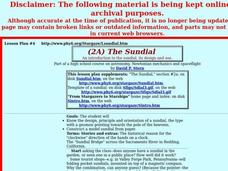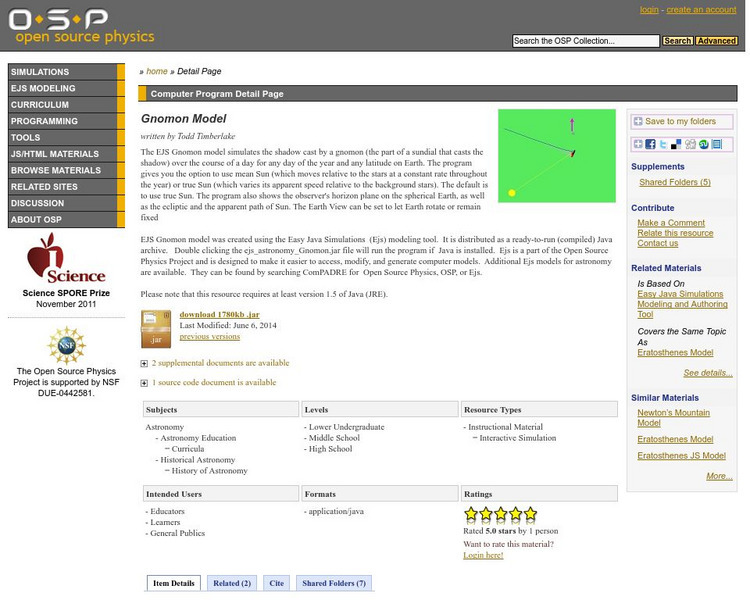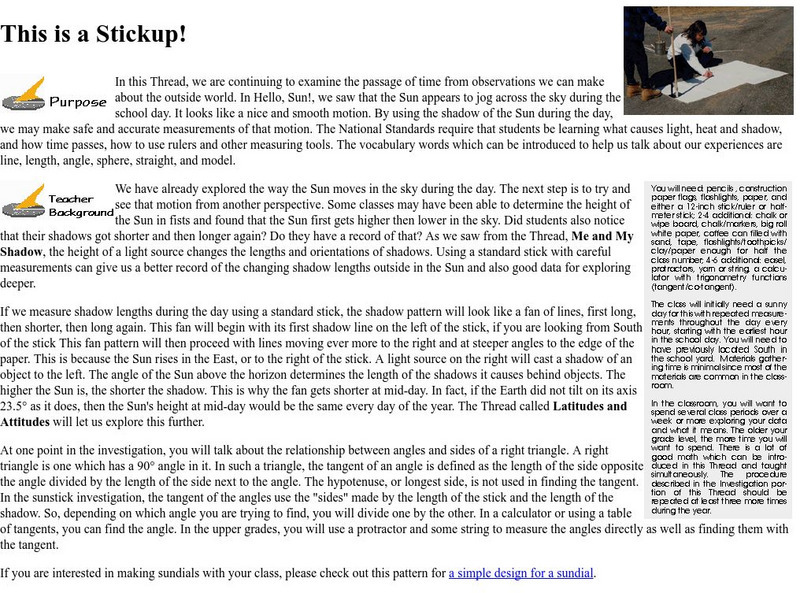Curated OER
Sun and Shadows
Why do shadows look different in the summer than in the winter? What causes day and night? How can a sundial be used to tell time? Answer these questions and more through two engaging lessons about light and shadows. Fourth and fifth...
Curated OER
SCHOOLYARD SUNDIAL
Students study the apparent motion of the Sun in the sky over the course of a day and a year, and analyze what causes seasons on Earth. They participate in a project that has both a science as well as an art component.
Curated OER
Time
Young scholars make a sundial. In this time lesson, students determine the time of the day by creating a sundial. They check the time on the sundial, hourly, for one week. Afterward, they explore what happened to the shadows in reference...
Curated OER
Timekeeping by the Sun
Young scholars measure shadows to learn about the Sun-Earth relationship. In this astronomy lesson, students create a shadow stick of a Pokemon character and record measurements of its shadow in a data chart. Follow-up discussions guide...
Curated OER
Shadow Interlude
Young scholars explore light and shadow and discover that the sun is the primary source of light. they explore the aspects of light and that the size and shape of a shadow depends on the proximity of the light source and create a sundial.
Curated OER
Science Trail
Students explore the solar system by conducting Earth science experiments. For this Sun lesson, students identify the different seasons on Earth and discuss their purpose and cause. Students create a sundial and observe the changes to...
Curated OER
Individual Horizontal Sundial 2: Cloud/Rain Activity
Students create a sundial to measure local apparent time as it relates to the position of the sun in the sky. In this sundial lesson plan, students cut and glue gnomon to a sheet of thin cardboard. Students then set the sundial in...
Curated OER
Individual Sundial (Cloud/Rain Activity)
Students make a simple sundial to examine the changes in shadows over time. For this sundial and shadow lesson, students make a simple sundial out of a manila folder and pencil. They observe how shadows change over time, and relate it to...
Curated OER
Make a Shadow Clock
Students create a shadow clock. In this time activity, students make their own shadow clock or sundial from tag board. They place it on the ground and check it every hour to mark where the shadow lies.
Curated OER
The Sundial of Space Exploration
In this science worksheet, high schoolers engage in the process of using a sundial to tell the time in various places. The sundial is meant to be cut out.
Curated OER
Stargazers and Skywatchers
Students are introduced to the apparent motion of the Sun across the sky and the way it changes in summer and winter.
Exploratorium
Exploratorium:seasons/shadows: Investigate How Shadows Shift Throughout the Year
Ancient Chacoans used shadows to tell daily time and seasons. Build a model that demonstrates the changes in Earth's tilt that affect the length of shadows relative to the sun that determines the seasons. The lesson plan uses everyday...
University of Oxford (UK)
The History of Scientific Instruments Used in Europe
Medieval and Renaissance-era scientific instruments are catalogued and displayed. Find references to the makers of the instruments and the ways the tools were once used.
TeachEngineering
Teach Engineering: Portable Sundial
In this activity students will investigate the accuracy of sundials and the discrepancy that lies between "real time" and "clock time". They will track the position of the sun over the course of a relatively short period of time as they...
Other
Center for Science Education: Eye on the Sky: Observing and Using Shadows
This resource provides all the directions and worksheets necessary to make a sundial and record data with it.
American Association of Physics Teachers
Com Padre Digital Library: Open Source Physics: Gnomon Model
A gnomon is the part of a sundial that casts the shadow. This simulated experiment illustrates the gnomon over the course of a day.
Harvard University
Eyes on the Sky, Feet on the Ground: The Earth's Rotation
Plenty of cool activities about the Earth's rotation can be found here, such as tracing shadows, observing shadows during different times of the day, and tracking the sun's path in the sky to understand the rotation of the earth.
Other
Lockheed Martin: Making a Horizontal Sundial
A website with directions on how to build a sundial for the Northern Hemisphere and information on how a sundial works. Includes three skill levels of construction.
Harvard University
University of Harvard: This Is a Stickup!
Students are taught how to make a sundial. The relationship between angles and the sides of a right triangle are explored. Great lesson plan ideas with plenty of background information. The activity is adapted for grade levels k-6 with...
Khan Academy
Khan Academy: Timekeeping
Why do we need calendars and clocks? To survive in this complex society, you need to track what others are doing and when they're doing it. You also need to know what's happening in the natural world. This article discusses how/why...
Curated OER
Eternal Egypt: Sundial (Sun Clock)
Aristarchus of Samos invented this type of sundial. It is in the form of a concave bowl, but is not like the usual sundial because it is hemispherical in shape, rather than circular.
Curated OER
Sundial Image
This resource provides all the directions and worksheets necessary to make a sundial and record data with it.























